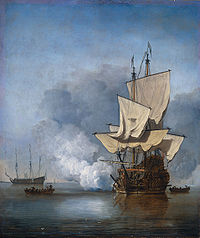- Man-of-war
-
This article is about the armed vessel. For other uses, see Man of war. For literal spelling with o', see Man O' War.
The man-of-war (also man of war, man o'war or simply man) was a Royal Navy expression for a powerful warship from the 16th to the 19th century. The term often refers to a ship armed with cannon and propelled primarily by sails, as opposed to a galley which is propelled primarily by oars. The man-of-war was developed in England in the early 16th century from earlier roundships with the addition of a second mast to form the carrack. The 16th century saw the carrack evolve into the galleon and then the ship of the line.
Contents
Development
The man-of-war was developed in England in the 17th century.[1] It derived from the carrack ship design, which ultimately derived from the caravel. The caravel was a Portuguese type of ship invented for initiating the Discoveries, and then for trading and transporting goods to trading posts. Most of Europe used the cog for trading, until the Portuguese Prince Henry the Navigator built a larger version he called caravela or caravel. He built up a strong navy, not of powerful warships, but of scouting and trading ships, amounting to 300 caravels. In the late 15th century, Spain and other nations adapted the caravel and invented a new ship, the galleon. In the early 16th century, Portugal created a smaller galleon called the carrack (nau in Portuguese). Henry VIII of England adapted it and called it a man-of-war, but Sir John Hawkins developed the legitimate man-of-war. The man-of-war was so successful that Sir Francis Drake created a smaller version he called the frigott or frigate. During the next two centuries, the man-of-war became even more popular. The most powerful warship in the world at the time was a Portuguese galleon that was nicknamed Botafogo (meaning "fire maker" or "spitfire").
Description
The man-of-war design developed by Sir John Hawkins had three masts which could be up to 200 feet long and could have up to 124 guns: 4 at the bow, 8 at the stern, and 56 in each broadside. All these guns required three cannon decks to hold them, one more than any earlier ship. It had a maximum sailing speed of eight or nine knots.
See also
- Ship of the line
- Rating system of the Royal Navy, which classified warships into six "rates", based on their armament. strongest as 1, weakest as 6.
References
External links
Types of sailing vessels and rigs - Barca-longa
- Barque
- Barquentine
- Bermuda rig
- Bermuda sloop
- Bilander
- Brig
- Brigantine
- Caravel
- Carrack
- Catamaran
- Catboat
- Clipper
- Dutch clipper
- Cog
- Corvette
- Cutter
- Dhow
- Dinghy
- East Indiaman
- Falkuša
- Felucca
- Fifie
- Fluyt
- Fore-and-aft rig
- Frigate
- Full rigged pinnace
- Full rigged ship
- Fusta
- Gaff rig
- Galeas
- Galleon
- Gunter rig
- Hermaphrodite brig
- Herring buss
- Hoy
- Jackass-barque
- Jangada
- Junk
- Ketch
- Koch
- Longship
- Lugger
- Man-of-war
- Mast aft rig
- Masula
- Mersey Flat
- Multihull
- Nao
- Nordland
- Norfolk punt
- Norfolk wherry
- Pausik
- Pilot cutter
- Pink
- Pinnace (ship's boat)
- Pocket cruiser
- Polacca
- Pram
- Proa
- Razee
- Sailing barge
- Sailing hydrofoil
- Scow
- Schooner
- Ship of the line
- Sixareen
- Sgoth
- Shitik
- Sloop
- Sloop-of-war
- Smack
- Snow
- Square rig
- Tall ship
- Thames sailing barge
- Trailer sailer
- Treasure ship
- Trimaran
- Uru
- Vinta
- Well smack
- Wherry
- Windjammer
- Windsurfer
- Xebec
- Yacht
- Yawl
- Yoal
Categories:- Ships articles needing expert attention
- Ship types
- Naval history
Wikimedia Foundation. 2010.

